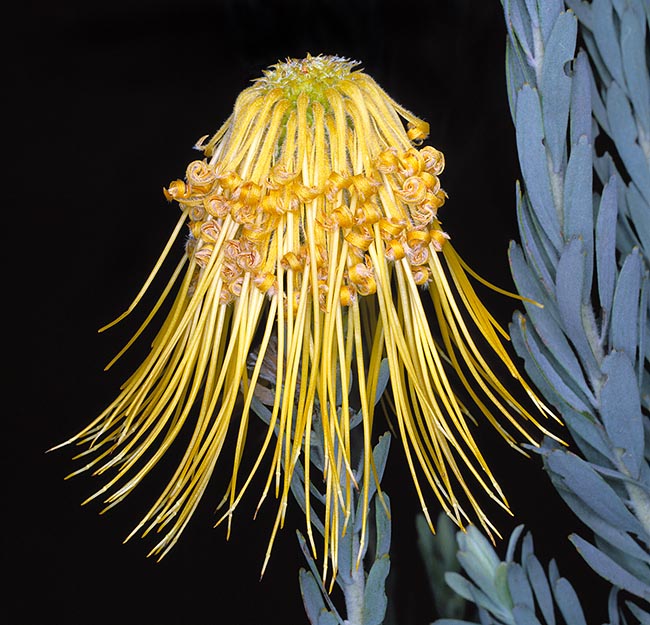Family : Proteaceae

Text © Pietro Puccio

English translation by Mario Beltramini

Leucospermum reflexum has orange-crimson inflorescences but often cultivated for the yellow variety © G. Mazza
The name of the genus is the combination of the Greek terms “leukos” = white and “sperma” = seed, with reference to the whitish fleshy pellicle covering the seeds; the name of the species comes from the Latin “reflexus, a, um” = bent backwards, bent, with reference to the flowers.
Common names: rocket pincushion, skyrocket leucospermum, sky-rocket pincushion (English); perdekorp (Afrikaans).
The Leucospermum reflexum H.Buek ex Meisn. (1856) is a shrub or small evergreen tree, up to about 4 m tall, with densely villous young branches and simple sessile leaves spirally arranged, coriaceous, elliptic to oblanceolate, of grey-green colour and covered by a thick grey down, 3-5 cm long and 0,5-1,5 cm broad, with 2-3 glandular teeth at the apex.
Solitary terminal inflorescences, of 8-10 cm of diameter, subtended by a casing of short imbricate bracts, carrying a crowd of flowers, initially erect, then bent downwards, formed by a tubular perianth formed by 4 petaloid tepals and a long dark orange to crimson style, rich of nectar which attracts the pollinators, especially birds. The fruit is an achene, about 0,8 cm long, covered by a fleshy pellicle (elaiosome) particularly appreciated by the ants which favour its dispersion. It reproduces by seed in sandy, particularly draining loam, or directly interred in autumn, a daily thermal excursion of about 10 °C favours its germination; the blooming takes place starting from the third year of age.
A yellow flower variety does exist, present in nature in few specimens, but amply cultivated and appreciated: Leucospermum reflexum H. Buek ex Meisn. var. luteum Rourke (1977).
Species of great ornamental effect due to the foliage and even more to the unusually shaped inflorescences, cultivable in full sun in the temperate climate zones of Mediterranean type, with mild and humid winters and warm and dry summers, not suitable for zones having warm and humid summers where it is easily subject to rottenness; adult plants can bear sporadic lowest values of temperature up to about -4 °C and drought periods.
It requires soils particularly draining, sandy or stony, slightly acidic, poor, in particular of phosphorus. The prunings are useful, to be done after the blooming, for a more compact and well tufted habit.
It adapts also to the cultivation in pot, which must be rather capacious, with substrata having the previously mentioned characteristics. The inflorescences are long-lasting even if cut and for such reason are used in the floral compositions.
→ Please look also the article about genus Leucospermum.
